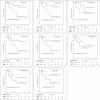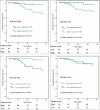Expression Profiles and Clinical Significance of MicroRNAs in Papillary Renal Cell Carcinoma: A STROBE-Compliant Observational Study
- PMID: 25906110
- PMCID: PMC4602701
- DOI: 10.1097/MD.0000000000000767
Expression Profiles and Clinical Significance of MicroRNAs in Papillary Renal Cell Carcinoma: A STROBE-Compliant Observational Study
Abstract
Papillary renal cell carcinoma (pRCC) is the second most prevalent subtype of kidney cancers. In the current study, we analyzed the global microRNA (miRNA) expression profiles in pRCC, with the aim to evaluate the relationship of miRNA expression with the progression and prognosis of pRCC.A total of 163 treatment-naïve primary pRCC patients were identified from the Cancer Genome Atlas dataset and included in this retrospective observational study. The miRNA expression profiles were graded by tumor-node-metastasis information, and compared between histologic subtypes. Furthermore, the training-validation approach was applied to identify miRNAs of prognostic values, with the aid of Kaplan-Meier survival, and univariate and multivariate Cox regression analyses. Finally, the online DAVID (Database for Annotation, Visualization, and Integrated Discover) program was applied for the pathway enrichment analysis with the target genes of prognosis-associated miRNAs, which were predicted by 3 computational algorithms (PicTar, TargetScan, and Miranda).In the progression-related miRNA profiles, 26 miRNAs were selected for pathologic stage, 28 for pathologic T, 16 for lymph node status, 3 for metastasis status, and 32 for histologic types, respectively. In the training stage, the expression levels of 12 miRNAs (mir-134, mir-379, mir-127, mir-452, mir-199a, mir-200c, mir-141, mir-3074, mir-1468, mir-181c, mir-1180, and mir-34a) were significantly associated with patient survival, whereas mir-200c, mir-127, mir-34a, and mir-181c were identified by multivariate Cox regression analyses as potential independent prognostic factors in pRCC. Subsequently, mir-200c, mir-127, and mir-34a were confirmed to be significantly correlated with patient survival in the validation stage. Finally, target gene prediction analysis identified a total of 113 target genes for mir-200c, 37 for mir-127, and 180 for mir-34a, which further generated 15 molecular pathways.Our results identified the specific miRNAs associated with the progression and aggressiveness of pRCC, and 3 miRNAs (mir-200c, mir-127, and mir-34a) as promising prognostic factors of pRCC.
Conflict of interest statement
The authors have no conflicts of interest to disclose.
Figures




Similar articles
-
MicroRNA profiles classify papillary renal cell carcinoma subtypes.Br J Cancer. 2013 Aug 6;109(3):714-22. doi: 10.1038/bjc.2013.313. Epub 2013 Jun 25. Br J Cancer. 2013. PMID: 23799849 Free PMC article.
-
MicroRNA expression profiles predict clinical phenotypes and prognosis in chromophobe renal cell carcinoma.Sci Rep. 2015 May 18;5:10328. doi: 10.1038/srep10328. Sci Rep. 2015. PMID: 25981392 Free PMC article.
-
Identification of 4-genes model in papillary renal cell tumor microenvironment based on comprehensive analysis.BMC Cancer. 2021 May 17;21(1):553. doi: 10.1186/s12885-021-08319-0. BMC Cancer. 2021. PMID: 33993869 Free PMC article.
-
Integrated Analysis Revealed the MicroRNA-Based Prognostic Predicting Signature for Papillary Renal Cell Carcinoma.DNA Cell Biol. 2021 Mar;40(3):532-542. doi: 10.1089/dna.2019.5306. Epub 2021 Feb 22. DNA Cell Biol. 2021. PMID: 33625263
-
Diagnostic and prognostic tissuemarkers in clear cell and papillary renal cell carcinoma.Cancer Biomark. 2010;7(6):261-8. doi: 10.3233/CBM-2010-0195. Cancer Biomark. 2010. PMID: 21694464 Review.
Cited by
-
Dysregulation of ncRNAs located at the DLK1‑DIO3 imprinted domain: involvement in urological cancers.Cancer Manag Res. 2019 Jan 15;11:777-787. doi: 10.2147/CMAR.S190764. eCollection 2019. Cancer Manag Res. 2019. PMID: 30697070 Free PMC article. Review.
-
How interacting pathways are regulated by miRNAs in breast cancer subtypes.BMC Bioinformatics. 2016 Nov 8;17(Suppl 12):348. doi: 10.1186/s12859-016-1196-1. BMC Bioinformatics. 2016. PMID: 28185585 Free PMC article.
-
MicroRNA expression profiles predict progression and clinical outcome in lung adenocarcinoma.Onco Targets Ther. 2016 Sep 15;9:5679-5692. doi: 10.2147/OTT.S111241. eCollection 2016. Onco Targets Ther. 2016. PMID: 27695346 Free PMC article.
-
The Significance Role of microRNA-200c as a Prognostic Factor in Various Human Solid Malignant Neoplasms: A Meta-Analysis.J Cancer. 2019 Jan 1;10(1):277-286. doi: 10.7150/jca.27536. eCollection 2019. J Cancer. 2019. PMID: 30662548 Free PMC article.
-
MicroRNA-1468 promotes tumor progression by activating PPAR-γ-mediated AKT signaling in human hepatocellular carcinoma.J Exp Clin Cancer Res. 2018 Mar 6;37(1):49. doi: 10.1186/s13046-018-0717-3. J Exp Clin Cancer Res. 2018. Retraction in: J Exp Clin Cancer Res. 2022 Sep 13;41(1):272. doi: 10.1186/s13046-022-02487-y. PMID: 29510736 Free PMC article. Retracted.
References
-
- Siegel R, Ma J, Zou Z, et al. Cancer statistics, 2014. CA: Cancer J Clin 2014; 64:9–29. - PubMed
-
- Rini BI, Campbell SC, Escudier B. Renal cell carcinoma. Lancet 2009; 373:1119–1132. - PubMed
-
- Cronin RE, Kaehny WD, Miller PD, et al. Renal cell carcinoma: unusual systemic manifestations. Medicine 1976; 55:291–311. - PubMed
-
- Twardowski PW, Mack PC, Lara PN., Jr Papillary renal cell carcinoma: current progress and future directions. Clin Genitourinary Cancer 2014; 12:74–79. - PubMed
Publication types
MeSH terms
Substances
LinkOut - more resources
Full Text Sources
Other Literature Sources
Medical

